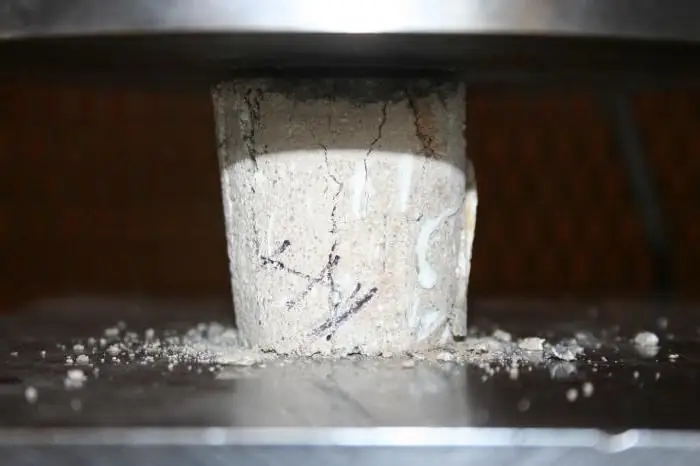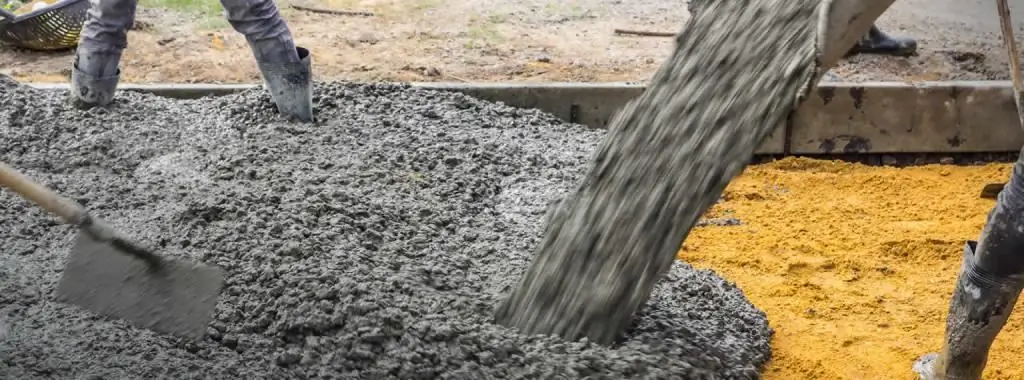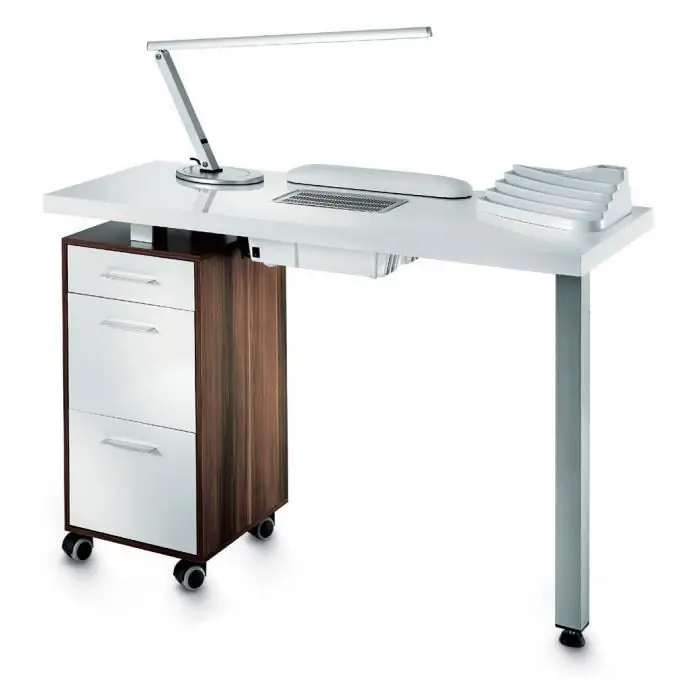2026 Author: Howard Calhoun | [email protected]. Last modified: 2025-01-24 13:10:38
The construction industry is one of the most developed, and therefore it uses a large number of various building materials with a variety of characteristics. And for some substances, such as concrete mixtures, for example, a number of requirements are immediately imposed. One of the important properties that each brand of mortar must have is the mobility of concrete. Consider it in the article.
General information
There is such a thing as workability. This term characterizes how the concrete mixture will fill the formwork with the selected compaction method and at the same time will form a compacted and homogeneous mass. To describe this property, such characteristics as connectivity, rigidity and mobility are used. A cone for the mobility of concrete (cone draft) is the property of a substance to spread over an area only due to its own weight. This parameter is the main one in the event that an assessment is made of the tolerance of the mixture for use on a specific construction site.

Mobility categories
It is important to note here thatthe convenience of using this solution lies precisely in the mobility of concrete. In addition, this parameter has several established flow rates. The dependence is approximately the following: the higher this characteristic, the better it will fill the formwork and flow around the bulk reinforcement, and it will also be better to spread over the formwork of complex configurations.
All concrete mixtures can be divided into two categories - low-slump and high-slump. All solutions belonging to the first category are not used in construction without prior mixing with plasticizers, as well as without undergoing a preliminary vibrocompression procedure. This category initially includes those brands that contain the above-mentioned plasticizers in small quantities.

Mobility dependence
In general terms, the mobility of concrete depends on factors such as quality and quantity, as well as on the constituent elements of the mixture.
If we consider the issue in more detail, then this parameter will depend on such properties as the brand of cement, the density of the cement paste, the ratio of water and cement, as well as the fraction and shape of the filler grain (sand and crushed stone).
It is worth noting that this factor will also change depending on the method of pouring the mixture into the formwork. For example, if a substance is poured into a dense and voluminous reinforcing cage, then it is necessary to choose a mixture whose mobility will be quite high. This is justified by the fact that it will be very difficult to apply vibrotamping in such conditions.difficult.
If a low-slump mortar is used under such conditions, then after the concrete compaction operation, it will not meet all the necessary standards, such as porosity or shells.

For this reason, when choosing a brand of composition, it is necessary to understand and know what requirements will be imposed on the supporting structure of the object, especially if the foundation is poured, and also know the exact conditions for pouring the substance into the formwork. You also need to take into account such characteristics as connectivity and rigidity.
Designation
In order to briefly indicate the indicator of the mobility of the element, use the letter "P". Depending on such a factor as gradation, I add an index to this designation. The higher the index value, the higher the fluidity of the composition. There are 5 grades of concrete mobility. Thus, all compositions from P1 to P3 are considered low-mobility, and P4 and P5 are classified as highly mobile.

For example, mortar P1 is used for purposes such as the construction of stairs. Although it is worth noting that, nevertheless, such concrete is rarely used, and at the same time it always passes through the mechanical compaction of the composition. Almost all standard buildings are built using such mobile concrete mixes as P2 and P3.
Stamps with the designation P4 are used in cases of erection of columns or high foundations. This category of work refers to dense reinforcement. Most Fluidmortar P5 is intended for pouring only into practically sealed formwork.
Cone draft
There are several methods that can be used to determine this parameter in a numerical value. The difference between these methods lies in the difficulty of obtaining the final result.
The fastest method is cone draft. This operation will determine how quickly the concrete will shrink under the influence of its own weight alone. It is important to note that the calculations are carried out on the condition that the solution is poured into a pre-prepared cone.
To determine the mobility class of concrete, therefore, it is necessary to use a cone-type metal mold. The dimensions of this form will depend on which crushed stone fraction is selected. Let's say the height of the cone is 300 mm, its small diameter is 100 mm, and the large one is 300 mm. With such indicators, the cone will have a volume of 7 liters.

Class definition
In order to determine the mobility index of concrete in this way, it is necessary to perform the following manipulations. Concrete mortar is placed in three portions in a cone-shaped form from its wide side. Each of these layers must be compacted through the use of a bayonet. It is necessary to make 8-9 movements for each layer, using smooth reinforcement for these purposes.
If an excess mixture is formed, then it must be removed. After that, the form must be turned over, like a children's cake. Thus, it will be possible to release the entire mixture that is inside. Thereaftersome time is given for the concrete to settle and the process of checking the amount of mobility is carried out.
To do this, calculate the reduced height of the solution relative to the upper edge of the form. In order to obtain a more accurate result or the arithmetic mean, it is necessary to repeat the procedure several times. The difference between the height of the cone - 300 mm and how much the concrete has settled, will be the mobility of the substance.

If there is no difference at all, then the mixture is assigned to the most rigid composition. If during the precipitation the difference reached up to 150 mm, then such a composition is considered to be inactive. If the difference has reached 150 mm or more, then the brand is considered highly mobile.
Second method
One of the methods to test the composition for mobility is the viscometer test. This method is used if the crushed stone fraction in the solution is in the range from 0.5 to 4 cm.
For the experiment, it is necessary to form a conical shape and pour concrete in the same way as in the previous experiment. After that, it is placed on a vibrating table. Next, a tripod is stuck inside the mold, on which there are divisions. A metal disc is put on top of it. After these operations, the vibrating table and, at the same time, the stopwatch are switched on. After that, it is necessary to detect the time during which the disk will fall to a certain mark. The resulting coefficient must be multiplied by a constant of 0.45. The numerical result of this action will determine the mobility of concrete.
Third method
Another method used isexperiments in forms. To conduct this experiment, you must have a cube with one open side. Dimensions of the container, for example, 200x200x200 mm. Such a cube can be used for all fractions of a mixture with crushed stone, up to 7 cm. A cone-shaped mass of concrete must be placed inside this device.
After these processes are completed, the cube is transferred to the vibrating plate. Here it is also necessary to simultaneously turn on both the stove and the stopwatch. In this experiment, it is necessary to detect the time during which the solution will fill all the corners of the cube, and the surface of the mixture will be completely flat.
The time that was obtained as a result must be multiplied by a constant coefficient of 0.7. The resulting number after multiplication will be an indicator of concrete mobility.
Concrete mobility table
In order to make it convenient to use concrete mixtures with different mobility indicators, they were systematized according to this feature. Other properties of workability were structured according to the same principle - coherence and rigidity. All this data was placed in the form of a table.
According to her, if the cone shrinks by 1-5 cm, then the substance belongs to rigid or heavy mobility. Concrete with this characteristic is marked P1. Grades P2 and P3 are characterized by cone shrinkage of 5-10 cm and 10-15 cm, respectively. The designation P4 indicates that the shrinkage is in the region from 15 to 20 cm. The remaining solutions, the mobility index of which exceeds 20 cm, belong to the group P5.

There is also GOSTconcrete mobility, which regulates the division of all types of mixture into several categories according to their main indicators. So, this state standard establishes the division of all solutions into two categories - these are ready-to-use mixtures (BSG) and dry mixtures (BSS). Further, it should be noted that there is a division into several groups, according to the workability of each substance. The first group is superhard (SJ), the second group is hard (F) and the third group is mobile (P).
In order to determine the quality of any brand of concrete, it is necessary to check its basic qualities: average density, workability, segregation and the volume of entrained air.
Recommended:
Architectural concrete: definition, types, features, types of processing and protection

Architectural concrete is a unique building material that can give any product a beautiful appearance. It is used both in the construction of buildings and in the creation of decorations
Thermal conductivity of concrete: features, coefficient and table

The thermal conductivity of concrete is determined by special formulas. For different types of material, this indicator may be different. Lightweight concrete retains heat better, heavy concrete worse
Determination of concrete strength: methods, equipment, GOST. Control and evaluation of concrete strength

When checking building structures, the determination of the strength of concrete is carried out to determine their state at the current time. Actual performance after the start of operation usually does not match the design parameters
Concrete mix: properties, composition, types, grades of concrete, characteristics, compliance with GOST standards and application

Among the main properties of the concrete mixture, which is also called hydrotechnical concrete, it is necessary to highlight the increased water resistance. Buildings are being built from this material to be used in swampy areas or in regions that are prone to flooding
How to choose a manicure table: tips and photos. manicure table size

Intending to take up nail services, the manicurist meticulously chooses items for his salon. The size of the manicure table plays a decisive role when buying, depending on the size of the room. How to choose it and what to look for - we will tell in our article

